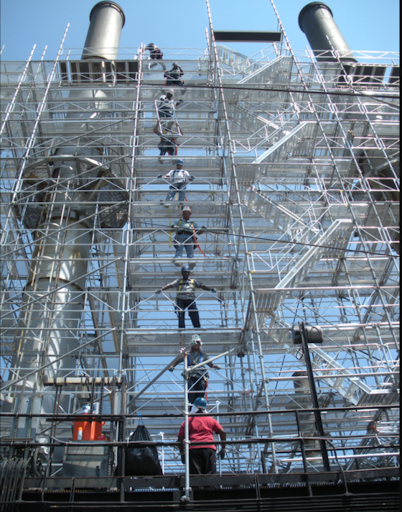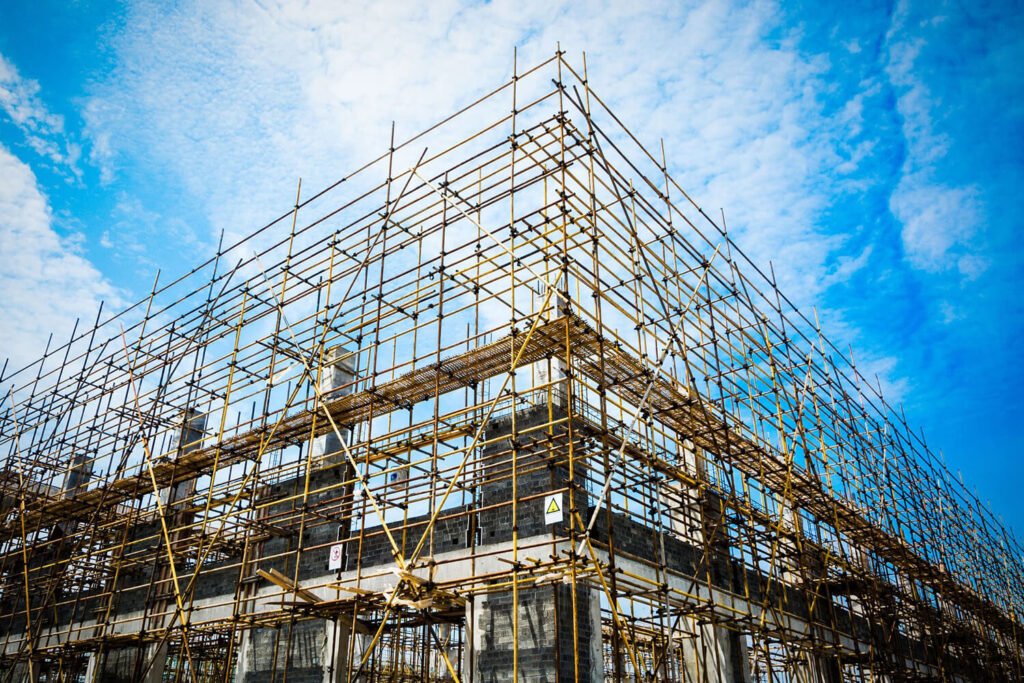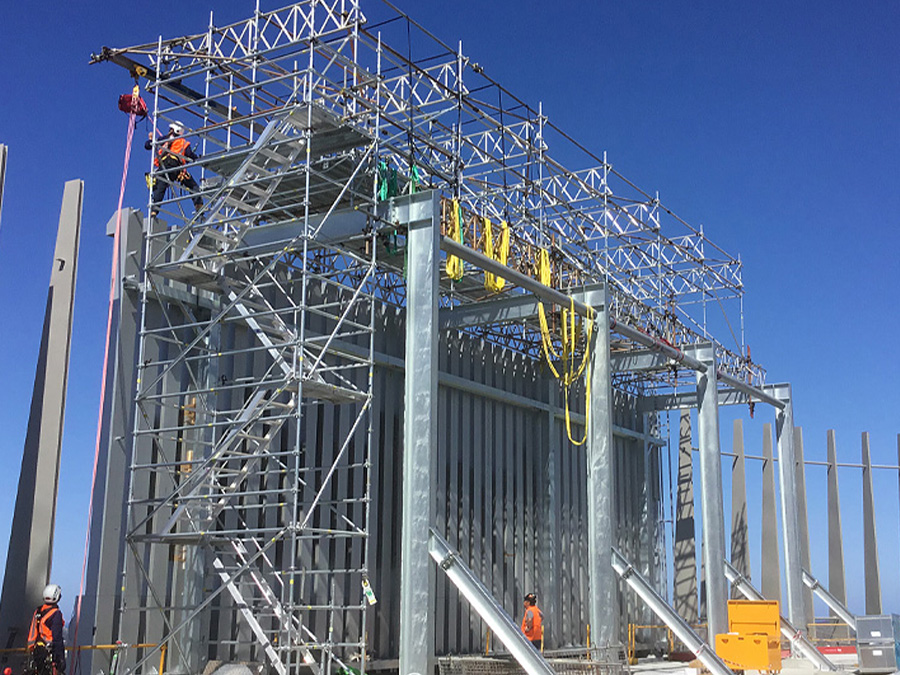Temporary Roof Scaffolding to Ensure Safe Working Conditions During Projects
Temporary Roof Scaffolding to Ensure Safe Working Conditions During Projects
Blog Article
Exploring the Numerous Types of Scaffolding Utilized in Building And Construction Tasks
The building and construction sector relies greatly on different sorts of scaffolding to meet details project demands, each offering distinct advantages and applications. Standard framework scaffolding provides a strong structure for basic tasks, while put on hold scaffolding is important for deal with high-rise structures. Various other alternatives, such as system and rolling scaffolding, provide to effectiveness and wheelchair, specifically. The cantilever variant confirms very useful in metropolitan settings where room is constrained. Recognizing the nuances of these scaffolding kinds is essential for maximizing safety and security and efficiency on building sites, motivating a more detailed exam of their one-of-a-kind features and applications.

Conventional Framework Scaffolding
Typical structure scaffolding is one of one of the most widely made use of approaches in the construction industry as a result of its toughness and flexibility. This system consists of upright and straight structures that are set up to create a stable system for materials and workers. The major components include vertical posts, straight ledgers, and diagonal dental braces, which together provide a strong framework that can sustain significant loads.
Among the vital advantages of standard frame scaffolding is its flexibility to various building projects, ranging from property buildings to big industrial frameworks. The modular design enables easy setting up and disassembly, making it effective for both lasting and temporary projects. Additionally, the system can be customized in elevation and width, fitting different structure layouts and website conditions.
Security is critical in scaffolding applications, and standard framework systems are geared up with guardrails and toe boards to stop falls and ensure employee security. Normal inspections and adherence to security laws are vital in maintaining the stability of the scaffold (Scaffolding). In general, traditional structure scaffolding remains an essential option in the building and construction industry, supplying a trusted platform for labor and boosting total task effectiveness

Suspended Scaffolding
Suspended scaffolding supplies an one-of-a-kind option for building tasks that require access to elevated surfaces, specifically in situations where traditional structure scaffolding might be unwise. This kind of scaffolding is usually suspended from the roof or top degrees of a structure, using a system of systems, sheaves, and ropes to produce a functioning space that can be gotten used to different elevations.
Among the key advantages of put on hold scaffolding is its flexibility. It can be conveniently repositioned or reduced to accommodate changes in building requirements, making it perfect for jobs such as window installation, façade job, and upkeep on skyscrapers. In addition, the marginal impact of suspended scaffolding enables for far better use ground space in city settings, where area is typically minimal.
Safety and security is an important consideration in making use of put on hold scaffolding. Correct rigging and anchoring systems should be utilized to guarantee stability and prevent crashes. Operators must likewise be educated in the secure use this equipment. In general, suspended scaffolding offers a reliable and efficient option for accessing hard-to-reach areas in various building and construction situations, enhancing both performance and security on website.
System Scaffolding
System scaffolding, commonly regarded as a modern service in the scaffolding sector, contains pre-engineered components that can be promptly assembled and adapted for numerous building projects. Scaffolding. like this This sort of scaffolding is identified by its modular style, which enables adaptability and efficiency on work sites, fitting architectural demands and various elevations
Typically made from high-strength steel or aluminum, system scaffolding provides boosted resilience and security. The elements include vertical posts, straight ledgers, and angled braces, which adjoin safely, guaranteeing a robust structure. The design often integrates standardized fittings, simplifying assembly and disassembly processes, therefore reducing labor time and costs.

Rolling Scaffolding
Rolling scaffolding is a flexible option to conventional set scaffolding, designed for mobility and simplicity of use on construction sites. This sort of scaffolding consists of a system sustained by frames with wheels, enabling employees to quickly relocate it as required. The flexibility attribute considerably enhances performance, as it reduces downtime connected with disassembling and putting together dealt with scaffolding.
Generally constructed from lightweight materials such as useful source aluminum or steel, rolling scaffolding offers a durable yet mobile remedy for jobs requiring regular repositioning - Scaffolding. It is specifically helpful in tasks such as paint, drywall installment, and electrical work, where accessibility to different elevations and locations is essential
Safety is paramount in rolling scaffolding style, with basics features such as locking wheels to stop unexpected movement when being used, and guardrails to safeguard employees from falls. Additionally, lots of versions are adjustable in height, fitting various task requirements.
Cantilever Scaffolding

The layout of cantilever scaffolding typically entails using arms or braces anchored to a building or framework, making it possible for the platform to prolong outside safely. Security is critical; hence, these scaffolds should be engineered to hold up against numerous tons and ecological conditions. Regular evaluation and upkeep are important to guarantee structural stability and employee security.
Cantilever scaffolding is preferred for its adaptability and effective use of room, making it a popular selection in metropolitan atmospheres where space restrictions are common. Moreover, it facilitates easier accessibility to high elevations, inevitably contributing to the general performance of building tasks. Just like all scaffolding kinds, appropriate training and adherence to security requirements are vital for employees using cantilever scaffolding.
Conclusion
To conclude, the diverse sorts of scaffolding used in construction jobs each serve unique functions customized to details site demands. Typical frame scaffolding gives security, while put on hold scaffolding uses flexibility for raised jobs. System scaffolding facilitates fast setting up, and rolling scaffolding boosts wheelchair for differing workplace. Cantilever scaffolding efficiently deals with obstacles in city setups. Comprehending these scaffolding types is important for optimizing safety and performance in building and construction, eventually contributing to the successful conclusion of jobs.
Conventional framework scaffolding offers a durable structure for basic tasks, while put on hold scaffolding is vital for work on high-rise frameworks.Rolling scaffolding is a functional option to traditional set scaffolding, designed for flexibility and simplicity of usage on building websites. As with all scaffolding types, appropriate training and adherence to safety requirements are critical for employees using cantilever scaffolding.
Typical framework scaffolding gives stability, while put on hold scaffolding offers adaptability for raised tasks. System scaffolding promotes quick assembly, and rolling scaffolding boosts mobility for varying job settings.
Report this page